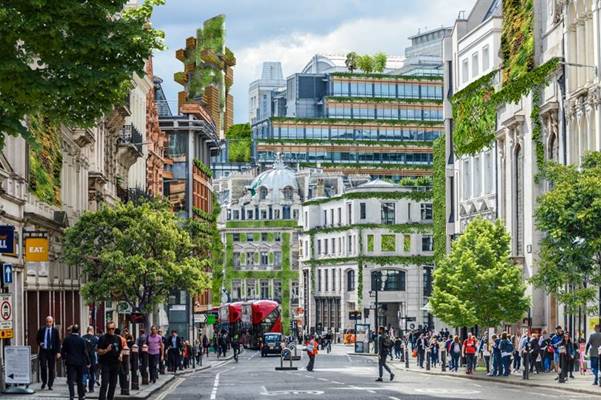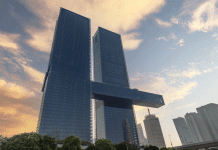Marshalls has explored the future of the UK’s building environments and how they can adopt more urban greenery to create eco-friendly cities
As the world becomes more urbanised and cities growing at an exponential rate, nature is being pushed to its limits. Eco-friendly cities are needed to bring back nature and help fight climate change.
Sustainable materials, water conservation, solar panels and roof gardens, vertical forests, and biomimicry can all be adopted to ensure our future cities are as environmentally sustainable as possible.
In fact, many of the UK’s cities and towns have already pledged to improve their natural environment by implementing a more urban forest atmosphere.
Mayor of London, Sadiq Khan has already committed £12m to a ‘Green City Fund’ to cover the cost of tree planting, green space grants, and the growth and management of the city trees in London. His goal is to ensure that more than half of London will be green by 2050.
How big is the market for eco-friendly buildings?
To find out how much importance is placed on environmental features in the current market, Marshalls asked 2,000 British residents for their opinion.
56% of respondents claimed they would always consider the environmental impact of a property when looking for a new home, whilst a further 12% revealed they would not even consider a property that didn’t have some level of environmentally friendly features.
Whilst planning in additional eco-friendly features into a project has the potential to increase costs, paying extra for a property with these features doesn’t seem to be an issue for many respondents.
Over 56% of respondents stated they would be happy to pay additional costs to ensure their home upheld a high level of sustainability. In terms of the value of this overspend, on average, those willing to pay more would spend an extra 10% for a property with sustainability features.
British people also believe that business owners and homeowners should foot the bill to ensure eco-friendly cities are delivered through features such as vertical forests, biomimicry and roof gardens.
Whilst many UK cities and towns have already pledged to improve their natural, research shows 62% of people believe any further developments in this field should be funded from private building owners, rather than councils or governments.
How could the future look?
Recently, architects and designers have begun embracing the “outside-in” trend; adopting more natural and plant-filled interiors which are said to help improve people’s moods and promote a connection to nature.
The new ‘green’ design isn’t solely applicable to interiors – many are looking for ways to cover building walls and rooftops with urban greenery to help encourage these health, wellness and environmental benefits.
The big shift we have seen is towards the use of natural materials and organic-landscaping to recreate nature in outdoor spaces and create eco-friendly cities.
London
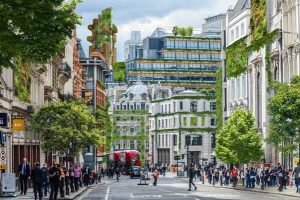
The nation’s capital boasts some of the most impressive architectural structures, and with approximately 8.8 million dwellers, as well as numerous high rises and monumental corporate buildings, bringing some urban greenery into the fold could really transform London into an eco-friendly city.
Trees and shrubs could grow on the facades of buildings helping to capture carbon dioxide, as well as producing oxygen. Not only would this bring colour and vibrancy to London it would also help to counteract the gasses emitted from cars, buses and motorcycles.
Glasgow
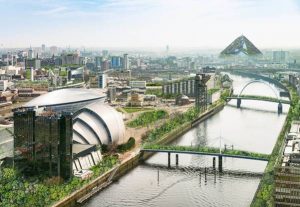
With the potential to be known as a “forest city”, the improvement to Glasgow’s overall look would be striking. With an array of walkways, bridges and paths filled with trees and shrubbery, Glaswegians could expect to feel immersed in nature from the moment they leave home, to the moment they return from work.
Birmingham
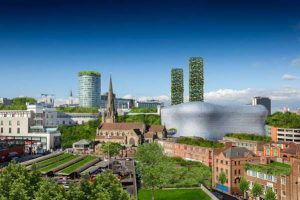
The new “capital of vertical forests”; thanks to the cities that tower over residential blocks and distinct lack of land availability, Birmingham could expect to see innovative ways of bringing more urban greenery to create an eco-friendly city.
Leeds
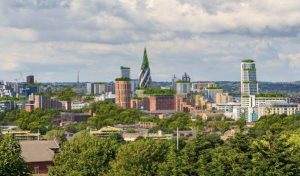
Thanks to the city’s impressive and forward-thinking architecture, some of Leeds’s spiralled buildings, designed to mimic forms of nature, could be decorated with plants and trees to emulate the power of all things natural.
Known as biomimicry, where architecture mimics natural forms, these buildings would be set to capture the carbon dioxide and work to produce oxygen. Not only could they counteract pollution, but they could improve the overall well-being and health of residents and visitors, too.
Chris Harrop, director of sustainability and marketing at Marshalls, commented: “It is encouraging to see so many people prioritising eco-friendly features in the decision-making process when looking for a new property.
“It can sometimes be a daunting experience to include additional features into a project, however, the study shows that there is a clear desire in the market to see more properties embrace these features.
“The industry is already embracing this trend and we have seen strong growth is in environmental and ethical product such as low-carbon permeable paving and high ethical standards.”


